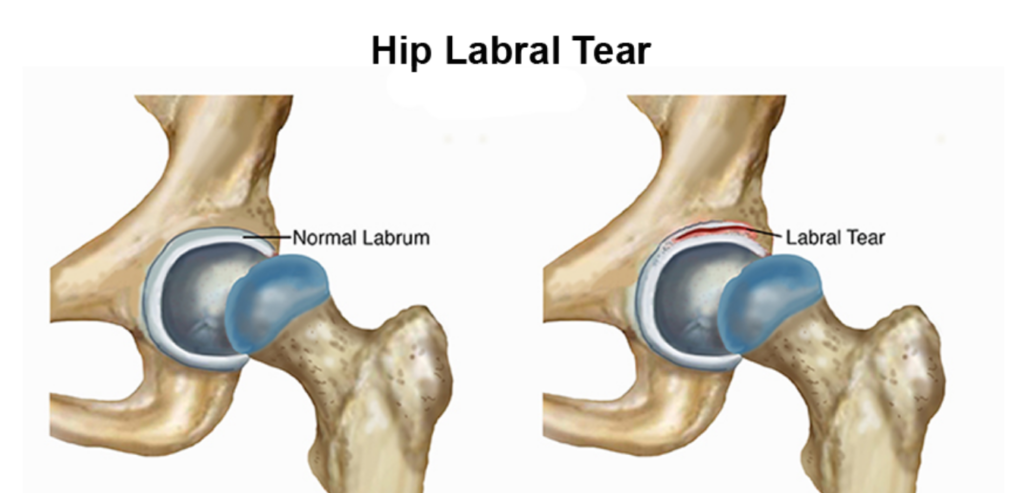Hip Labral Hear Symptoms Causes Treatment Preventions & More All you need to know
The labrum is a type of cartilage found in a ball-and-socket joint. The shoulder and the hip joints are of this variety. The bones in a joint are held together by ligaments and supported by labral cartilage. A labral tear may involve the shoulder or hip joint.
A hip labral tear involves the labrum, ring of cartilage found on the outside rim of the hip joint socket.

Anatomy of the hip labrum
A joint has two types of cartilages;
- Articular cartilage, white-coloured cartilage present at the ends of the bones and allows the bones to glide and move on each other.
- The labrum is more fibrous and rigid than the articular cartilage. It is found exclusively around the socket where it is attached.
The labrum performs two functions.
- Firstly, it deepens the socket to accommodate the ball in the socket of the other bone. The labrum is a thick tissue that goes all the war around, attaching itself to the rim of the socket joint and forms a bumper to add depth to the socket.
- Secondly, the labrum provides an attachment site for other structures or tissues around the joint. For example, the ligaments, tendons, and muscles involved in a joint.
The labrum of the hip joint cushions it and acts like a rubber seal or gasket that holds the ball at the top of the thighbone tightly secured in the hip socket.
The hip joint forms at the junction of the thigh bone (femur) with the pelvis (ilium). The bony socket is surrounded by the labrum, catering to add stability and shock absorption.
Causes of labral tear
Sports that cause injuries involving labral tears include;
- Hockey
- Soccer
- Football
- Ballet
- Long-distance running
Fall, direct impact injury or accidents may involve the labrum. Extreme motion, repetitive twisting, or sharp movements like cutting lie at the root of the labral damage.
The labrum may pull away entirely or partially tear away. Repetitive loading injuries that happen in hip impingement predispose the hip joint to labral tear by placing more stress on the labrum.
A combination of factors lead to labral tear like;
- Abnormalities of the bones involved in hip joint
- Tightness or weakness of the muscles involved in the hip joint
- Instability of the hip joint
- Use of improper technique while performing repetitive activities
- Gradual wear-and-tear over time
In case of a complete tear, the labrum cannot heal without surgical intervention. The hip joint is cleansed, repaired with the labrum reconstructed. Months of physical therapy is required for complete functional devolvement.
Physical therapy in the initial stages of injury helps strengthen and increase the mobility and flexibility of the hip.
Signs and symptoms of labral tear
Depending upon the severity of the injury, a hip labral tear may be asymptomatic or may cause significant disability, pain or limited movement.
Pain is usually felt in the front region of the thigh or in the groin. It can cause limitations in standing, walking, squatting, climbing stairs and playing sports, etc.
You may experience the following signs and symptoms with a labral tear;
- A deep nagging ache in the front of your hip or groin
- Pain is gradual in onset and may be associated without any incident
- Clicking or catching sensation with hip movements; the feeling is associated with pain, an individual may feel as if something unpleasant is stuck in the hip, which is blocking hip motion
- Pain gets worse with prolonged sitting or walking
- Sudden sharp pain in the hip or groin when squatting
- A feeling of the hip bone giving away due to weak muscles of the hip joint
- Stiffness in the hip that limits movement
Diagnosis of the labral tear
History and physical examination along with x-ray and MRI scans confirm the diagnosis.
Treatment of labral tear
- Immediately after an injury to first few weeks
- RICER
Rest for your hip pain hip and avoiding aggravating activities is the first line of therapy for a labral tear. The aim is to reduce pain and prevent further damage. Such a patient should avoid;
- Sitting with knees lower than your hips
- Sitting with legs crossed
- Sitting on your legs with hip rotation
- Sitting on the edge of a seat and flexing the hips
Any move that results in overextension of the hip should be avoided.
- Medication
- Nonsteroidal anti-inflammatory drugs; ibuprofen (Advil, Motrin IB, others) and naproxen sodium (Aleve)
- an injection of corticosteroids into the joint
- TENS
- Surgery
An arthroscopic surgery, if conservative treatment fails, is taken up for labral tear. A fiber-optic camera and surgical tools are inserted into the hip joint via small incisions in the skin.
The surgeon may remove the torn piece of the labrum or repair the torn tissue.
- After few weeks
- Massage
Massage in case of hip labral tear helps to relieve tension in the muscle. It alleviates pain by improving circulation. Massage uses distraction techniques to gently open and stretches the joint.
Muscle tightness of the hip flexors, the groin muscles (adductors), the deep hip rotators (piriformis), and the tensor fascia lata (TFL) have debilitating effects on the quality of life. Massage techniques like the following help to ease the tight muscles;
- Trigger point therapy
- Targeted stretches and self-release
- Active release techniques
- Sports massage
- Dry needling
- Therapeutic ultrasound
Ultrasound therapy after surgery or few weeks into the hip pain helps to speed healing and repair.
- Active rehabilitation
All the cases of labral tears are treated under the consultation of a physical therapist. The aim is to develop a plan to achieve specific goals like a return to sports.
Identification and modification of triggering factors causing pain is essential.
The therapist may design an individualized treatment plan beginning with rest followed by a gradual return to appropriate activities.
Learn to self-stretch the lower body to decrease pressure. A progressive resistance program to address the muscles of the core and lower extremity is added. Strengthening exercises that are done while lying down and in a standing position are advised.
Functional training to minimize tension on the hip for safe and controlled movements must be adopted to improve the quality of life in patients with a labral tear.
Some exercises for hip labral tear include;
Side Stepping with Resistance
Also called a monster walk, this exercise uses a resistance band to strengthen the outside of the hips.
- Stand with a resistance band adjusted between your thighs.
- Hinge a bit at the hips.
- Take side steps to your right.
- Repeat on the left side.
- Make sure to keep your pelvis stable.
- Taking wide steps will disengage the resistance in the band. So take small side steps that keep the resistance steady.
Side leg raise
- Lie down on the floor. Begin with your left side.
- Stack your legs together on top of each other.
- Keep your forearm on the floor. Either rest your head on the forearm or prop up on its support.
- Now lift your right leg and hold it there for few seconds.
- Bring the leg back down and repeat for at least ten reps.
- Switch sides. Do the same on the opposite right side.
Deadlift with Single Leg
- Hold a lightweight barbell with both of your hands. Keep them at the front.
- Stand with your feet hip-width apart. Keep the feet parallel.
- Slowly lean forward at your hips.
- Gradually shift the weight onto one leg and stand on its support. Keep a slight bend in this leg to avoid injury.
- Engage your other leg and move it in an extension behind you.
- Keep the leg straight and take it up till you are comfortable.
- The arms with the weight should hang straight down.
- Ideally, you should be forming a T figure with your body.
- Slowly bring the extended leg back. Switch sides and do the same with the opposite leg.
- Perform ten reps on each side.
Prevention of labral tear
Sports and long-distance running activities cause repetitive motion increases the risk of sustaining a labral injury.
Since there may no signs and symptoms, it is crucial to be aware of pain during sitting or squatting.
Continuing with mobility and muscle strengthening practices of the lower limb is essential.
Warm-up and cool down with stretching should accompany all physical activities.



